| 21 September |
• yesterday • tomorrow |
| Feast of Saint Matthew, Apostle and Evangelist |
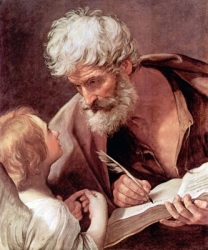
• Levi
• Apostle of Ethiopia
• 16 November (Eastern calendar)
• 6 May (translation of his relics)
Son of Alphaeus, he lived at Capenaum on Lake Genesareth. He was a Roman tax collector, a position equated with collaboration with the enemy by those from whom he collected taxes. Jesus' contemporaries were surprised to see the Christ with a traitor, but Jesus explained that he had come "not to call the just, but sinners."
Matthew's Gospel is given pride of place in the canon of the New Testament, and was written to convince Jewish readers that their anticipated Messiah had come in the person of Jesus. He preached among the Jews for 15 years; his audiences may have included the Jewish enclave in Ethiopia, and places in the East.
• accountants; bookkeepers
• bankers
• customs officers
• financial officers; money managers
• guards; security forces; security guards
• stock brokers
• tax collectors
• diocese of Trier, Germany
• archdiocese of Washington, DC
• 5 cities
• angel holding a pen or inkwell
• bag of coins
• halberd
• inkwell
• king
• lance
• man holding money
• money bag or box, purse
• spear
• sword
• winged man
• young man
• art
• books
• cards
• medals and pendants -
( page 01 )
( page 02 )
( page 03 )
( page 04 )
( page 05 )
( page 06 )
( page 07 )
( page 08 )
( page 09 )
( page 10 )
( page 11 )
( page 12 )
( page 13 )
( page 14 )
( page 15 )
( page 16 )
( page 17 )
( page 18 )
( page 19 )
( page 20 )
( page 21 )
( page 22 )
( page 23 )
( page 24 )
( page 25 )
( page 26 )
( page 27 )
• other jewelry
• rosaries -
( page 01 )
( page 02 )
"Jesus saw a man called Matthew sitting at the tax office, and he said to him: Follow me." Jesus saw Matthew, not merely in the usual sense, but more significantly with his merciful understanding of men." He saw the tax collector and, because he saw him through the eyes of mercy and chose him, he said to him: "Follow me." This following meant imitating the pattern of his life - not just walking after him. Saint John tells us: "Whoever says he abides in Christ ought to walk in the same way in which he walked." "And he rose and followed him." There is no reason for surprise that the tax collector abandoned earthly wealth as soon as the Lord commanded him. Nor should one be amazed that neglecting his wealth, he joined a band of men whose leader had, on Matthew's assessment, no riches at all. Our Lord summoned Matthew by speaking to him in words. By an invisible, interior impulse flooding his mind with the light of grace, he instructed him to walk in his footsteps. In this way Matthew could understand that Christ, who was summoning him away from earthly possessions, had incorruptible treasures of heaven in his gift. - from a homily by Saint Bede the Venerable
https://catholicsaints.info/saint-matthew-the-apostle/
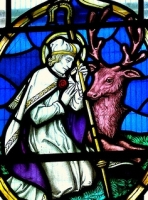
• Cadoc of Wales
• Cadoc the Wise
• Catrwg Ddoeth
• Cadocus, Cadog, Cadvaci, Cadvael, Cathmael, Cattwg, Docus
Son of Saint Gwynllyw, a king in Wales, a robber chieftain who led a band of 300; his mother, Saint Gladys, had been stolen in a raid on a neighboring chief; brother of Saint Gluvias. Raised by an Irish monk; Cadoc's father had stolen the monk's cow, and when he came to demand its return, the king decided it was sign. Studied in Wales and Ireland. Priest.
Once chased through a wood by an armed swineherd from an enemy tribe. His hiding place spooked an old, gray, wild boar that made three great leaps at him - then disappeared; Cadoc took this as a sign, and the location became the site of the great church and monastery at Llancarvan, Wales; the house became renowned for the learning and holiness of its monks.
Legend says he once saved his brother monks in a famine by tying a white thread to the foot of a (well-fed) mouse; he then following the thread to an abandoned, well-stocked, underground granary. Another time he and his brothers went out to meet a band of thieves, chanting and playing harps; it surprised the highwaymen so much, they turned and left.
Lived as a hermit with Saint Gildas on the Island of Flatholmes off Vannes, Brittany. Established a monastery on a small island just off Brittany, joined by a stone bridge so local children could walk out for school. Returned to Britain to evangelize, and work with Christian survivors of Saxon raids. Martyr.
6th century Welsh
killed by Saxons c.580 while serving at Mass near Weedon, Northamptonshire, England
• against cramps
• deaf people; against deafness
• against glandular disorders
• against scrofula
https://catholicsaints.info/saint-cadoc-of-llancarvan/
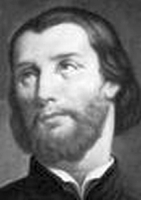
24 November as one of the Martyrs of Vietnam
Studied at seminaries in Melan, then Chambery in France in 1819. Member of the Society of Foreign Missions of Paris. Priest. Missionary to Cochin-China in 1824, Macao in 1825, and Tonkin in 1826. He was arrested more than once for preaching Christianity, he was pardoned because of his skill as a translator, which was useful to the king. However, he gained too many converts, and in 1838 he was arrested, tortured and murdered for his faith. One of the Martyrs of Vietnam.
16 September 1799 at Onion, Haute-Savoie, France
• strangled to death on 21 September 1838 in Nhan Bieu, Quang Tri, Tonkin, Indo-China (modern Vietnam)
• buried near Tonkin by local Christians
• later moved to the Seminary for Foreign Missions, Paris, France
19 June 1988 by Pope John Paul II
https://catholicsaints.info/saint-francois-jaccard/
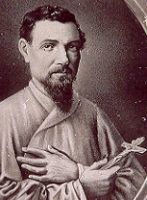
• Jakob Chastán
• James Chastán
Ordained in 1826. Joined the Paris Society of Missions in 1827. Missionary in Thailand, then Malaysia, and then Korea, arriving on 31 December 1836. Worked with Saint Lawrence Imbert, Saint Peter Maubant and Saint Paul Chong Hasang. Lived and worked in secret for over two years, spreading Christianity during a period of persecution. Arrested on 6 September 1839. One of the Martyrs of Korea.
7 October 1803 in Marcoux, Basses-Alpes, France
beaten with a bastinado and beheaded on 21 September 1839 at Saenamteo, Seoul, South Korea
6 May 1984 by Pope John Paul II in Korea
https://catholicsaints.info/saint-jacques-honore-chastan/
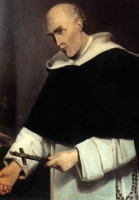
Mark of Modena
Born to the nobility. Joined the Dominicans in Modena, Italy. Priest. Noted preacher throughout central and northern Italy. Prior of the Dominican monastery in Pesaro, Italy. Miracle worker.
c.1420 in Mocogna, Modena, Emilia-Romagna, Italy
• 21 September 1498 in Pesaro, Italy
• buried in the Dominican church in Pesaro
• relics transferred to the chapel of Our Lady of the Rosary in Pesaro
• relics transferred to the Franciscan church in Pesaro when the chapel was destroyed
• relics transferred to the Domincan church in Modena, Italy in 1949
10 September 1857 by Pope Blessed Pius IX (cultus confirmed)
https://catholicsaints.info/blessed-mark-scalabrini/
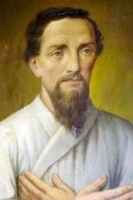
Peter Maubant
Ordained in the Diocese of Bayeux, France in 1829. Joined the Foreign Missionary Society of Paris. Missionary to Korea, arriving on 12 January 1836. Worked with Saint Lawrence Imbert, Saint Jacques Chastain, and Saint Paul Chong Hasang. He worked in secret for two years, ministering to covert Christians during a period of great persecution. Arrested on 6 September 1839, he was executed for the crime of spreading Christianity. Martyr.
20 September 1803 at Vassy, Calvados, France
beheaded on 21 September 1839 in Saenamteo, Seoul, South Korea
6 May 1984 by Pope John Paul II in Seoul, South Korea
https://catholicsaints.info/saint-pierre-philibert-maubant/
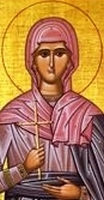
Born to the nobility. A pious child, her prayers caused her the conversion of her father who had lived a dissolute life. After his death, she stayed with her mother Sedulia, and worked for the spiritual growth of her brother Eutropius, who became bishop of Troyes, France. She devoted most of her time to prayer and charity, and fasted every Wednesday and Friday. She made altar vestments, tabernacle candles, and anything else that could help at Mass. Reported to have worked miracles, but insisted that the those she helped keep it to themselves so as not to draw attention to her. Friend of Saint Prudentius of Troyes, who wrote a biography of her.
827 at Troyes, Champagne, France
850 at Troyes, Champagne, France of natural causes
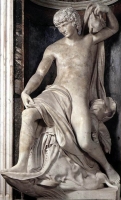
Ionas, Jonas, Yona, Yunaan, Yunus
Old Testament patriarch and prophet. Hero of the Book of Jonah, he was so reluctant to deliver his prophecy against the city of Nineveh that God had to have him swallowed by a giant fish and then spat out on the city's shore.
• c.761 B.C.
• tradition says he was buried in a tomb in modern Mosul, Iraq
• the tomb was enclosed in a shrine in the 8th century BC
• the tomb and shrine were destroyed by Muslims in July 2014
https://catholicsaints.info/jonah-the-prophet/
May have been the brother of Saint Leontius of Frejus; records are unclear. May have been a lawyer. Layman, married to a wealthy widow from Marseilles, France. With mutual consent, both he and his wife entered religious life. Founded the Monanque monastery in Provence (in modern France). Abbot. Bishop of Apt, Gaul (in modern France). Saint John Cassian wrote De Institutis Coenobiorum at Castor's request.
Nîmes, France
• c.420 of natural causes
• relics in the cathedral of Apt, France
Apt, France
https://catholicsaints.info/saint-castor-of-apt/
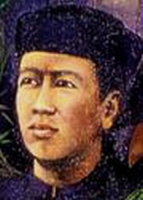
24 November as one of the Martyrs of Vietnam
Entered the seminary of the Paris Foreign Missionary Society in the apostolic vicariate of Cochinchina, Vietnam in his late teens. Martyr.
c.1820 in Trung Quán, Quang Bình, Vietnam
beaten and strangled on 21 September 1838 in Nhan Bieu, Quang Tri, Vietnam
19 June 1988 by Pope John Paul II
https://catholicsaints.info/saint-toma-tran-van-thien/
Second century bishop in the area around Rome, Italy. Miracle worker. Arrested, tortured and executed for his faith. Martyr.
• martyred on the Via Claudia, about three miles outside Rome, Italy
• relics translated to a church in Rome in the late 4th century
• Pope Damasus I wrote an epitaph for Saint Alexander
https://catholicsaints.info/saint-alexander-of-the-via-claudia/
Gerulfo, Gerolfo
Young man in Flanders, Belgium who was heir to a large estate but was drawn to spiritual life. Murdered by a relative who hoped to inherit Gerulph's wealth; Gerulph was on his way from having received the sacrament of Confirmation. As he died, Gerulph pardoned his murderer. Honoured as a martyr by the faithful in the area.
746 in Tronchiennes (Drogen), Flanders, Belgium
https://catholicsaints.info/saint-gerulph/
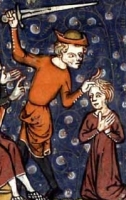
Openly declared himself a Christian during an unspecified period of persecution in Phoenicia. Tortured and executed. Martyr.
https://catholicsaints.info/saint-eusebius-of-phoenicia/
John Rider
Lay man. Martyr. A letter he wrote from prison has survived.
Korean
1839 in Korea
6 May 1984 by Pope John Paul II
https://catholicsaints.info/saint-johannes-ri/
Martyr.
on the Via Salaria Antica, Rome, Italy, date unknown
https://catholicsaints.info/saint-pamphilus-of-rome/
Convert, brought to the faith by Saint Matthew the Apostle.
1st century in Ethiopia
https://catholicsaints.info/saint-iphigenia/
Isacius
Bishop in Cyprus. Martyr.
https://catholicsaints.info/saint-isaac-of-cyprus/
Bishop in Cyprus. Martyr.
https://catholicsaints.info/saint-meletius-of-cyprus/
Three brothers, Eusebius, Nestulus and Zeno, who were seized, dragged through the street, beaten and murdered by a pagan mob celebrating the renunciation of Christianity by Julian the Apostate. Martyrs.
burned to death in 362 on a village garbage heap in Gaza, Palestine
https://catholicsaints.info/martyrs-of-gaza/
Thousands of people were murdered in the anti-Catholic persecutions of the Spanish Civil War from 1934 to 1939. I have pages on each of them, but in most cases I have only found very minimal information. They are available on the CatholicSaints.Info site through these links:
• Blessed Diego Hompanera París
• Blessed Jacinto Martínez Ayuela
• Blessed José María Azurmendi Mugarza
• Blessed Josep Vila Barri
• Blessed Manuel Torró García
• Blessed Nicolás de Mier Francisco
• Blessed Vicente Galbis Gironés
• Blessed Vicente Pelufo Orts
• Caterina Aliprandi of Asti
• Landelino of Ettenheim
• Quadrato of Magnesia
• Tristan of Salazar
CatholicSaints.Info Portable Edition